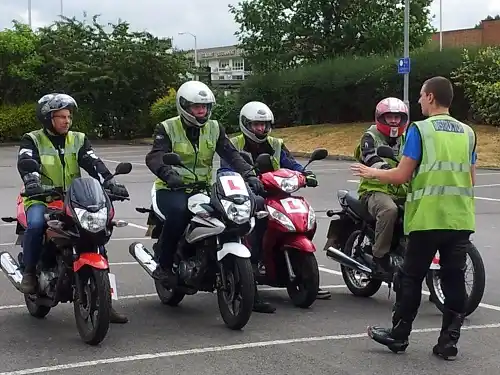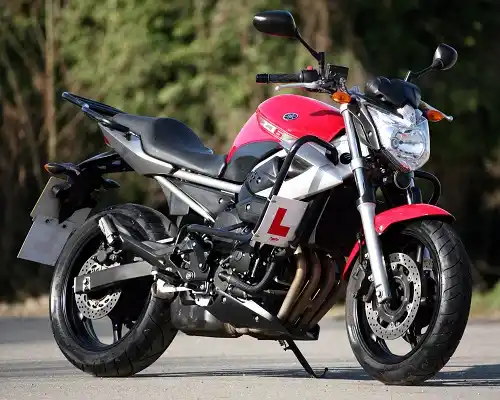Book motorcycle training in Southall, Greater London with any of the companies listed here
Click on any of the motorcycle training schools below to view more information and check availability.
Circa Motorcycle Training Osterley
Indian Gymkhana Club, Thornbury Avenue, Isleworth, Greater London, TW7 4NQ
Approx. distance: 2.5 miles
Passmasters Motorcycle Training Ltd Greenford
David Lloyd Centre, Greenford Road, Sudbury Hill, Greater London, UB6 0HX
Approx. distance: 3.7 miles
Universal Motorcycle Training Wembley
82 Sunleigh Road, Wembley, Greater London, HA0 4LR
Approx. distance: 4.1 miles
Heathrow Motorcycle Training Hounslow
Feltham & Hanworth Airparks Leisure, Hanworth, London, TW13 5EG
Approx. distance: 4.9 miles
West London Motorcycle Training Feltham
Fairholme School, Peacock Avenue, Feltham, TW14 8ET
Approx. distance: 5 miles
Alpha Motorcycle Training Wembley
6 Lumen Road, Wembley, London, HA9 7RE
Approx. distance: 5.1 miles
Lightning Motorcycle Training Wembley
Sattavis Patidar Centre, Forty Avenue j/w The Avenue, Wembley Park, London, HA9 9PE
Approx. distance: 5.6 miles
Twickenham Motorcycle Training Middlesex
Kempton Park Racecourse, Staines Road East, Sunbury On Thames, Middlesex, TW16 5AQ
Approx. distance: 6.5 miles
Off The Kerb Motorcycle Training Shepherds Bush
White City Ta Centre, London, W12 7RW
Approx. distance: 6.5 miles
Universal Motorcycle Training Edgware
The Hive London, Edgware, London, HA8 6AG
Approx. distance: 7.4 miles

Find motorcycle training in Southall, Greater London
Are you trying to book your motorcycle training in Southall or close by in Ealing, Greenford and Osterley? Here at BookCBTNow we are one of the most trusted sources of online booking for motorcycle training companies. We can help you find your local training company and help you get your training for the A1, A2 or DAS motorcycle test.
What are the different types of motorcycle licence I can get in Southall?
There are 4 main types of full motorcycle licence issued by the DVSA. The first three (AM, A1 and A2 motorcycle licences) have restrictions on the type of moped or motorcycle you can ride, the fourth (the full A motorcycle licence) has no restrictions.
The AM restricted moped licence
The A1 restricted motorcycle licence
The minimum age to take this test is 17. According to the DVSA website it will allow you to ride a "Light motorcycle up to 11 kW (and a power-to-weight ratio not more than 0.1 kW per kg) and 125 cc". This means it's up to a 125 cc motorcycle with some restrictions to make sure it cannot accelerate too fast - a really good idea when you are new to riding a motorbike!
Requirements to take the A1 motorcycle test - You must have a UK provisional or full driving licence, a valid theory test certificate and a valid CBT certificate. Once you have taken this test you will not have to keep renewing your CBT certificate every 2 years, you can ride on motorways and you can take a pillion passenger on the back of your motorbike.
The A2 restricted motorcycle licence
For this licence you need to be at least 19 years of age, have completed your CBT or have had an A1 licence for at least 2 years. As with the A1 test you also need to have a UK provisional or full driving licence and a valid theory test certificate . The main benefit of getting an A2 licence is you can ride a more powerful motorcycle. The law states a "standard motorcycle up to 35 kW (and a power-to-weight ratio not more than 0.2 kW per kg)". So it's a more powerful bike, but still not completely un-restricted. To find A2 legal motorbikes you are best visiting your local motorcycle dealer and asking them to show you the A2 legal bikes, as otherwise it's very difficult to work out just looking at the tech specs.
The full A motorcycle licence, or DAS licence.
This is the licence that allows you to ride almost any motorcycle without restrictions, so it's the ultimate motorcycle licence. No limits on power outputs or power per kg or engine size! It is also called a 'DAS' licence as it can be obtained from the 'Direct AccesS' route. There are two ways you can get this licence:
1) If you are 24 or over you can take the tests for an A licence. You must also have a UK provisional or full driving licence, a valid theory test certificate and a valid CBT certificate.
2) If you are at least 21 years of age and you have held an A2 category licence for at least 2 years. This is sometimes referred to as the 'progressive access' route as you progress from one licence to another.
When taking the test the biggest difference is that you have to use a bigger, more powerful motorcycle. It will have a power of at least 40kw and an engine cc of at least 595 cc. Your local training school will make sure you have the right size bike for your test.
There is also a flowchart (click here) that the DVLA have produced that shows these different licences and how to obtain them.
To get more detailed guidance on what licence is right for you then talk to your local motorcycle training school. You can search for them here and they are qualified to speak to you on the right type of training for you.
How do I get the right training in Southall for the full A motorcycle licence?
The A motorcycle licence (also known as the DAS licence) is an unrestricted licence you can get when you are 24 or over. You are allowed to ride any road legal motorcycle of any power or engine size. You can also get the full A licence if you are younger than 24 if you pass your A2 restricted licence first. After holding the A2 restricted licence for 2 years you are able to take the tests for a full A licence. Given that the earliest you can take the A2 test is 19 then the earliest you could take your full A test is 21. It is essential that you get the right training for this licence as without it you are likely to hurt yourself or even worse, someone else. Use this website to enter your postcode and search for your local motorcycle training school. They are all fully qualified to advise you on the training you will need. Although saving money is something everyone wants to do, the right training will save your life. Therefore don't just focus on price, look at the quality of training on offer and the standard of training.

What is the Enhanced Rider Scheme (ERS)?
This scheme was devised by the DVSA and the motorcycle industry. The ERS course is run by many motorcycle training companies around the UK. It is for anyone who has a full motorcycle licence and wishes to check their safe riding skills. Not only will it make you a better rider but some insurance companies offer cheaper motorcycle insurance if you have been issued with a DVSA Certificate Of Competence. You will receive this certificate at the end of your ERS course if the instructor deems you to be a safe rider. If the instructor feels you need additional training it may be given on the day, or if it is felt you need a larger amount of training then you may need to come back on another day. Although ERS is not a test it is much like a CBT: provided you demonstrate a safe level of riding and knowledge during the day then you will be issued with your certificate.
The DVSA has produced a short video showing what the Enhanced Rider Scheme is all about:
Click here to watch DVSA video
What can I ride on a provisional driving licence in Southall?
A provisional driving licence is not a full driving licence so you are limited in what you can ride. So, when you first come to ride a motorcycle the DVSA will issue you with a provisional driving licence. What you can ride will depend on your age.
Age 16
You must complete a CBT and then you can ride a moped or scooter up to 50 cc and with a top speed of no more than 28 mph. You must display L plates, you cannot carry a pillion passenger and you must not ride on a motorway.
Age 17 or over
You must complete a CBT and then you can ride a restricted motorcycle up to 125 cc. You must display L plates, you cannot carry a pillion passenger and you must not ride on a motorway.
Do you have a full car driving licence?
If you already have a full car driving licence then this automatically gives you provisional entitlement for riding a motorcycle. So, priovided you get your CBT certificate then you can ride a moped or motorcycle as mentioned above according to your age.